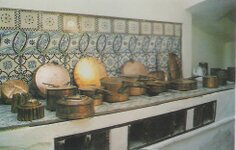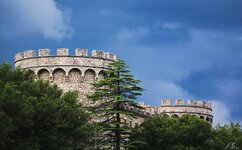Pignatelli Castle in Monteroduni
 The absence of information, let us thing that the origins of the fact that San Michele Arcangelo is the patron saint of Monteroduni can be traced in the Lombard period, when the Prince of the Angels was considered the protector of the old and new fortified towns. In the whole valley of the Volturno, from Venafro to Isernia, and to the lands of San Vincenzo, there is the cult of San Michele (or simply to S. Angelo) in the towns where on the upper part of the hills are set Lombard fortresses and castles to defend the territory and the first urban settlements. Certainly, the town of Mount of Roduni (name which probably derives from one of the Lombards who owned the hill), was smaller than today and already inhabited before the 1000. The first mention about the fortification of Monteroduni dates back to the time of Henry VI, when Berthold of Kunsberg, chief of German and Florentine soldiers, attacked in 1193 the castle which, at that time, was held by Tancredi. As reported by Ciarlante, while Berthold was placing his war machines near the city walls, people inside the fortress threw a stone, with a particular machine called Manganella, and killed Berthold. The story, reported by Richard of St. Germano in his chronicles, doesn’t tell us anything about the creation of the city of Monteroduni, but it is useful to understand that the castle was a very important part of the entire system of fortresses in the Matese.
The absence of information, let us thing that the origins of the fact that San Michele Arcangelo is the patron saint of Monteroduni can be traced in the Lombard period, when the Prince of the Angels was considered the protector of the old and new fortified towns. In the whole valley of the Volturno, from Venafro to Isernia, and to the lands of San Vincenzo, there is the cult of San Michele (or simply to S. Angelo) in the towns where on the upper part of the hills are set Lombard fortresses and castles to defend the territory and the first urban settlements. Certainly, the town of Mount of Roduni (name which probably derives from one of the Lombards who owned the hill), was smaller than today and already inhabited before the 1000. The first mention about the fortification of Monteroduni dates back to the time of Henry VI, when Berthold of Kunsberg, chief of German and Florentine soldiers, attacked in 1193 the castle which, at that time, was held by Tancredi. As reported by Ciarlante, while Berthold was placing his war machines near the city walls, people inside the fortress threw a stone, with a particular machine called Manganella, and killed Berthold. The story, reported by Richard of St. Germano in his chronicles, doesn’t tell us anything about the creation of the city of Monteroduni, but it is useful to understand that the castle was a very important part of the entire system of fortresses in the Matese.The present castle has nothing to do with the original Longobard fortification, although with absolute certainty it occupies a key part of it. An examination of the old city walls, in fact, let the scholars assume that the oldest part of the fortress of Monteroduni can be detected in the buildings that overlook the so-called Porta Falsa where there are signs of a square tower, which is prior to the Angevin period. From this tower, which was perhaps the most important defensive element of the first town (a cluster of wooden houses), started a long and strong wall, which today could match the current wall which surround the garden castle. This very simple defensive structure, around the fourteenth century during the Angevin period, was equipped with towers. The introduction of firearms and the fact that the town itself expanded outside the original limits caused a changing in the shape of the town: even the Angevin towers were leveled to become small bulwarks which could accommodate some blasting machines. These changes took place presumably after 1503, when the city of Monteroduni became the property of Ludovico d’Afflitto, whose descendants held it until 1668. Although there are no inscriptions or reports about the architectural shape of the castle in that period, we can reasonably assume that the building had substantially its present feature, even if it was smaller and lower. When there was no need to defend the town anymore, Prince Giovanni Pignatelli della Leonessa, began a substantial transformation of the castle to let it become exclusively a residence. Pignatelli’s files are particularly useful to understand the conditions in which the Royal Family found the building once they bought it and which works were made to renovate and adapt it to the needs of the time. In the early eighteenth century they started the rebuilding of the great hall, which had a wooden ceiling made up of 190 panels of oak painted in tempera. Nowadays, after the restoration it’s possible to enjoy every little detail of the original painting in the ceiling.
Renovated several times over time, the castle took its present shape around the beginning of this century when the merlons all around the towers were built. It is also conceivable that the transfer, reported in some papers, from Rome to Monteroduni of the brothers Jeremia and Domenico Ferretti, skilled marble workers who created the baptistery in the local San Michele Church, was due precisely to the making of some important portals in red cravel of the Matese, ordered by Pignatelli. Certainly dated before the sixteenth century is the great staircase that connects the small courtyard to the main floor. The great stone table reporting the toll of the Pandetta that were paid to cross the Lorda is dated 1752 and is located near the main entrance since 1890, close to the eighteenth-century door surmounted by the crest of the Pignatellis.

The Feudal Lords of Monteroduni
At the age of the Lombards the whole territory of Basso Molise was divided into Dukedoms. Monteroduni, along with Venafro and Isernia, belonged to the Duchy of Benevento and was administered by the Gastaldis.
Later, the Duchy of Benevento was divided into thirty Counties. In 964 Monteroduni was administered by the County of Isernia, more precisely by Count Landolfo and his successors until 1064. From 1064 to 1268 the area was ruled by the Counts of Molise and from 1268 to 1278 by Eustachio D’Ardicourt. In 1281 it became a fief of the D’Evolis, in 1326 it was owned by the De Sus Family and in 1333 administered by the Queen Sancia. Later, the D'Evolis and the Trincis started a battle to conquer the land; but in 1441 it became the property of the Gaetani Family. The D’Afflitto Family, then, ruled Monteroduni until the advent of the Pignatellis.
Info for guided tours:
Comune di Monteroduni
Info: Tel. 0865.491586 - 491531












